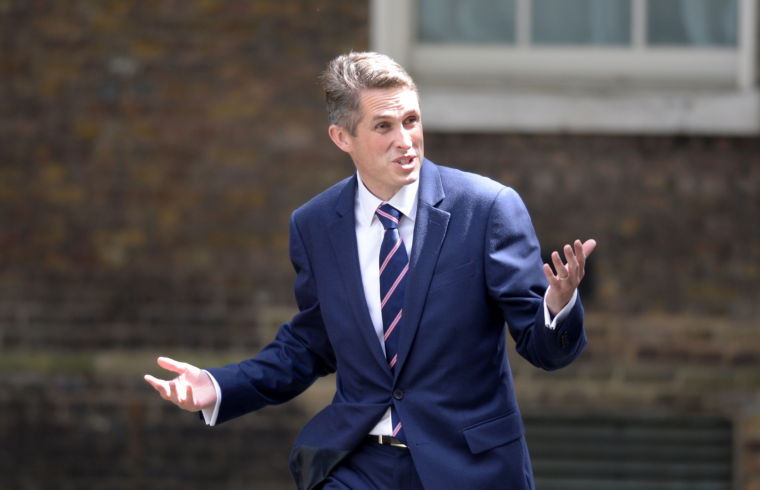Photographer: OLI SCARFF/AFP
Photographer: OLI SCARFF/AFP
When the U.K. government announced the cancellation of exams to prevent the spread of the coronavirus, there was a collective intake of breath from parents and a giant exhalation from students. These yearly trials usually dominate the beginning of summer for British families with school-age children, who are tested to within an inch of their lives. A-levels — taken at 18 in three or four subjects following a two-year course of study — determine whether and where a pupil can go to university.
Most kids were pretty hopeful when exams were cancelled (shocking, right?). Prime Minister Boris Johnson had promised that this year’s students wouldn’t be worse off. He pledged to “make sure that pupils get the qualifications they need and deserve for their academic career.” An algorithm would input previous exam grades, teacher references, student rankings in each subject and the school’s historic performance to award grades that would be “fair and robust.”
What emerged was the opposite. No wonder Johnson has taken the humiliating step of abandoning the technology and falling back on the flawed model of teacher-predicted grades.
The government failed because it didn’t deliver on its promise: It quickly became apparent that pupils — especially poorer ones — weren’t getting the grades they deserved. No algorithm can predict how a student copes in the final stretch of that two-year marathon, those months when endless practice papers and the refining of exam technique can make the difference. Most kids don’t know themselves until they’ve been through it.
The first sign that artificial intelligence wasn’t up to the job of grading exams for school leavers was the debacle in the International Baccalaureate, another pre-university qualification that’s popular with students in many countries. The IB is a rigorous and well-regarded body, so it seemed suited to the experiment of how to grade kids who hadn’t done their final exams because of lockdown.
When teachers predict A-level grades, typically three-quarters of them are overstated. But IB predictions are usually highly accurate, with more than 90% of grades matching teacher predictions. The International Baccalaureate Organization had hundreds of thousands of data points going back decades to help fine-tune its algorithm. It didn’t help. When the IB results came out in early July, there was an immediate outcry from schools around the world: Tens of thousands of grades were much lower than predicted. Protests, petitions and lawsuits followed.
Britain’s A-level results prompted a similar response when they were published last week. While beleaguered education minister Gavin Williamson tried to insist no changes were required, it was a bit like Noah denying it would rain. As results poured in, the government tried to put a smiley face on it: There are more students than ever going to university and more from disadvantaged backgrounds, ministers noted. There was a 2% increase overall in the number of pupils getting the top two grades — A and A*.
At any other time, that would have counted as a modest victory. But the testimony from schools, headteachers and many students told a different story. Nearly 40% of grades were marked down from the levels that teachers and schools had assessed and that meant many pupils hadn’t qualified for their preferred courses. The biggest dip in results came disproportionately in more deprived areas.
For a government that had put “leveling up” Britain’s left-behind regions and bridging its big inequalities — not least in the country’s education system — at the heart of its every message, this wasn’t just a bad look. It was a complete disaster.
Students can apply to a maximum of five universities in Britain. If they’re lucky enough to get more than one offer, they can hold two places based on offers that are usually conditional on their exam results. If the student doesn’t get the required grades, the offer is withdrawn. A downgrade of even one grade can close the door to some, especially in more competitive courses such as medical school.
Monday’s capitulation gives students grades that were assessed by their schools. These are presumably more robust than those used when university applications are being made because they’ve been done later and on the basis of more data points. But the about-face doesn’t undo all the damage. Many university courses have already been filled. The government is lifting a cap it imposed on the number of new university students, so that should help, but colleges are trying to work out how to teach with social distancing, which puts a strain on resources.
How did the government get it so wrong? In education, as with many policy areas for this government, there was political baggage to factor in. “The background to the algorithm is long-term distrust of teachers among those running education in the Conservative Party,” says Tim Bale, a politics professor at London’s Queen Mary University. The government seemed fixated on controlling the number of university places and preventing grade inflation.
As with many of Britain’s other coronavirus missteps, inadequate preparation and wrong priorities resulted in a policy that had to be reversed. You’d think by now that lessons would have been learned on the need for pragmatism.
This column does not necessarily reflect the opinion of the editorial board or Bloomberg LP and its owners.
To contact the editor responsible for this story:
James Boxell at jboxell@bloomberg.net











